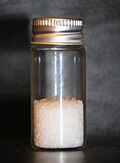
| |

| |
| Names | |
|---|---|
| Other names
PVOH; Poly(Ethenol), Ethenol, homopolymer; PVA; Polyviol; Vinol; Alvyl; Alcotex; Covol; Gelvatol; Lemol; Mowiol; Mowiflex, Alcotex, Elvanol, Gelvatol, Lemol, Nelfilcon A, Polyviol und Rhodoviol
| |
| Identifiers | |
| ChEMBL | |
| ChemSpider |
|
| ECHA InfoCard | 100.121.648 |
| E number | E1203 (additional chemicals) |
| KEGG | |
| RTECS number |
|
| UNII | |
CompTox Dashboard (EPA)
|
|
| Properties | |
| (C2H4O)x | |
| Density | 1.19–1.31 g/cm3 |
| Melting point | 200 °C (392 °F; 473 K) |
| log P | 0.26 [1] |
Refractive index (nD)
|
1.477 @ 632 nm[2] |
| Hazards | |
| NFPA 704 (fire diamond) | |
| Flash point | 79.44 °C (174.99 °F; 352.59 K) |
| Lethal dose or concentration (LD, LC): | |
LD50 (median dose)
|
14,700 mg/kg (mouse) |
| Safety data sheet (SDS) | External MSDS |
Except where otherwise noted, data are given for materials in their standard state (at 25 °C [77 °F], 100 kPa).
| |
Polyvinyl alcohol (PVOH, PVA, or PVAl) is a water-soluble synthetic polymer. It has the idealized formula [CH2CH(OH)]n. It is used in papermaking, textile warp sizing, as a thickener and emulsion stabilizer in polyvinyl acetate (PVAc) adhesive formulations, in a variety of coatings, and 3D printing. It is colourless (white) and odorless. It is commonly supplied as beads or as solutions in water.[3][4] Without an externally added crosslinking agent, PVA solution can be gelled through repeated freezing-thawing, yielding highly strong, ultrapure, biocompatible hydrogels which have been used for a variety of applications such as vascular stents, cartilages, contact lenses, etc.[5]
Although polyvinyl alcohol is often referred to by the acronym PVA, more generally PVA refers to polyvinyl acetate, which is commonly used as a wood adhesive and sealer.
- ^ "Poly(vinyl alcohol)". ChemSrc.
- ^ Schnepf MJ, Mayer M, Kuttner C, et al. (July 2017). "Nanorattles with tailored electric field enhancement". Nanoscale. 9 (27): 9376–9385. doi:10.1039/C7NR02952G. hdl:10067/1447970151162165141. PMID 28656183.
- ^ Cite error: The named reference
Ullmannwas invoked but never defined (see the help page). - ^ Tang X, Alavi S (2011). "Recent Advances in Starch, Polyvinyl Alcohol Based Polymer Blends, Nanocomposites and Their Biodegradability". Carbohydrate Polymers. 85: 7–16. doi:10.1016/j.carbpol.2011.01.030.
- ^ Adelnia, Hossein; Ensandoost, Reza; Shebbrin Moonshi, Shehzahdi; et al. (2022-02-05). "Freeze/thawed polyvinyl alcohol hydrogels: Present, past and future". European Polymer Journal. 164: 110974. Bibcode:2022EurPJ.16410974A. doi:10.1016/j.eurpolymj.2021.110974. hdl:10072/417476. ISSN 0014-3057. S2CID 245576810.
